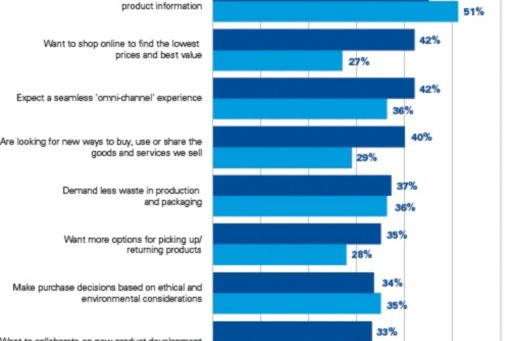Becoming hyper customer centric
Becoming hyper customer centric
Becoming more customer centric creates an omni-channel business.

To compete in a global marketplace with shifting demographics, even today’s best-in-class consumer companies require a deeper, multi-dimensional understanding of their customers. Hyper customer-centricity brings the customer into sharper focus through the use of advanced data analytics and smart technologies to track and anticipate consumer behavior in near-real time and deliver personalized products and experiences when, where, and how the customer wants them.
However, keeping up with fast-changing customer demands can be a challenge, as our survey results show. For example, although half of the surveyed companies believe their customers want better in-store service and experiences, only one-third say they are successfully meeting these demands. Similarly, 42 percent of respondents said their customers want to shop online to find the lowest price and best value, yet only 27 percent felt they were successfully responding. Other areas in which companies were falling short include delivering an omni-channel experience, offering new business models and providing options for picking up or returning products.
Consumer companies lagging behind customer demands

Thinking differently about customer behavior
The first step in getting closer to customers is rethinking how to use data and analytics for deeper customer insights. “Best-in-class companies are going outside their CRM systems to learn about their customers,” says Bill Nowacki, Managing Director, Data & Analytics, KPMG in the UK. “They are developing more fine-grained data about their customers, including their non-spend characteristics. They are putting sensors around their customers to detect subtle shifts in demand.”
Nowacki cites three types of data that world-class consumer companies need to harness to explain how and why a customer acts throughout their shopping journey: circumstantial, situational, and demonstrated behavior data.
Companies need to gather and analyze as much circumstantial, situational, and demonstrated behavior data as possible so they can start to understand the motivation for why, when, and how a consumer makes a purchase decision at any given time. “Brands are going to have to excel at culling these insights from sources they own, as well as sources they don’t,” says Nowacki.
Drawing on smarter analytics
To gain greater customer knowledge, the companies in the survey said they would be investing significantly in smarter analytics and technologies. While 29 percent of surveyed companies reported that they are using big data analytics today that number doubles to 58 percent over the next two years.
"The use of predictive analytics and artificial intelligence will double by 2018"
The use of predictive analytics, customer path-to-purchase analytics, and artificial intelligence are also expected to double during that timeframe, to 59 percent, 54 percent and 43 percent, respectively. Other analytical tools targeted for fast growth include real-time tracking systems, scenario modeling and stress testing and micro targeting capabilities.
In addition to utilizing cognitive analytics, Jeanne Johnson, Consulting Partner at KPMG in the US, believes that companies should concentrate on customer path-to-purchase analytics to find their place in the omni world.
“By paying close attention to customer path-to-purchase mapping, consumer companies will be able to understand emerging shifts in customer dynamics,” says Johnson. “In some cases, consumers are moving faster than we expected. They are drawing on new channels, new methods, and new paths to purchase. And some are moving as slowly as they were before. The risk is thinking that everybody is moving at the same pace. They are not, and path-to-purchase analytics will help guide their judgment.”
Over the next two years, companies will be increasing their use of advanced analytics to achieve customer priorities such as: creating relevant, personalized customer experiences (56 percent), optimizing distribution and cost-to-serve (51 percent) and better forecasting customer demand (49 percent).
Putting a laser focus on the customer
Today’s corporate priorities are centered squarely on the customer. The executives who took part in our survey rated sustaining customer loyalty, improving customer service and experience and building customer trust as their top three priorities, with each being a priority with nearly a third of respondents.
Just behind, in fourth place, 29 percent of executives also said that enhancing their supply chain agility and flexibility, arguably the backbone of a customer-centric business model, would be a top priority in the coming year).
Hyper customer sensitivity is particularly vital for succeeding in emerging markets, where consumer needs and behaviors can vary sharply from those in the Western world.
“As a consumer living in China, I would say that we have some of the most technologically advanced customers in the world,” says Jessie Qian, Head of Consumer Markets at KPMG in China. While the digital behaviors of Chinese consumers may be similar to those in Western markets, there are some big differences in attitudes.
“In the developed world, there are more regulations and greater customer loyalty. In the West, people have grown up with brands. They are part of their lives. But the consumer market in China has only really developed over the last 20 years. So consumers frequently change from brand to brand.”
Millennials move to center stage
With Millennials now accounting for two billion of the world’s7.4 billion population, this segment is fast emerging as the number one source of consumer spending. As such, it’s easy to see why the executives in our survey believe Millennials will be a boon to their businesses.
The companies surveyed hope to capitalize on a number of Millennial behaviors. These include spending more on health (33 percent), gravitating to socially aware brands (30 percent), valuing shopping experiences that go beyond products (30 percent), and shopping through mobile devices (28 percent).
At the same time, Millennials are presenting challenges for consumer companies. Surveyed executives cited a range of hurdles when selling to this generation of young adults. At the top of their list of challenges are: lower level of disposable income (30 percent), aversion to traditional advertising (26 percent), influence by online reviews and endorsements (25 percent) and their tendency to browse but not buy (24 percent).
Whether they pose more of an opportunity or a challenge, Millennials are a driving force impacting consumer- oriented companies. Colleen Drummond, Head of the KPMG Innovation Lab in the US, believes that Millennials are key influencers of consumer market trends. “Millennials tend to be early adopters, “says Drummond.
“Their influence spreads virally and their behaviors transfer between generations very rapidly. Uber is a great example. Many Boomers heard about if from their children and then started to use it. Their behavioral change happened in days or weeks, not months or years.”
"Of all the currents of change running through the consumer marketplace Millennials are the greatest disruptor."
Our survey revealed that companies are using an arsenal of techniques to target Millennials. The most common approaches include adding value-priced products (45 percent), providing more product information (38 percent), increasing investment in mobile channels and apps (34 percent), and creating an integrated Omni-channel platform (33 percent). In particular, fast-growing companies, those that report at least 10 percent revenue growth last year, have Millennials in their cross hairs.
More than half (51 percent) of these companies said they would be adding value-priced products, over a third are better integrating their omni channel and e-commerce platforms (40 percent), and over a third (39 percent) are building customer experiences that specifically target Millennials.
“Of all the currents of change running through the consumer marketplace, Millennials are the greatest disruptor,” says Willy Kruh. “Boomers also spend heavily, but Millennials have growing influence and the extraordinary ability to shape consumer behavior.”
“If the majority of Millennials do not trust traditional advertising,” asks Kruh, “what does that mean for your marketing strategy?” Kruh believes that many companies have yet to fully adjust to the rising influence of Millennials. “Millennial habits,” says Kruh, “are turning business conventions on their heads.”
KPMG International Cooperative ("KPMG International"), a Swiss entity. Member firms of the KPMG network of independent firms are affiliated with KPMG International. KPMG International provides no client services. No member firm has any authority to obligate or bind KPMG International or any other member firm vis-à-vis third parties, nor does KPMG International have any such authority to obligate or bind any member firm. All rights reserved.